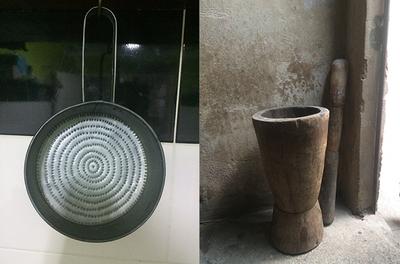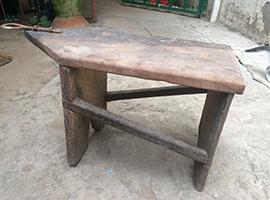Blog Entry #1
At the risk of repeating what every single ethnographer of Maputo states about the place, my first few months doing fieldwork in the capital of Mozambique have been a process of understanding to what extent the city is split in two.
2018.01.05 | Middle Class Urbanism
Rus in Urbe: a city life embedded in rural modes of production and consumption.
At the risk of repeating what every single ethnographer of Maputo states about the place, my first few months doing fieldwork in the capital of Mozambique have been a process of understanding to what extent the city is split in two. The physical space, the economy, forms of interaction and even the dress code in the “reed city” and the “cement city” are of two completely different kinds. And although there isn’t much caniço [reed] left in Polana Caniço, the neighbourhood is not simply striving to imitate the cement city, but instead producing new forms of its own. The area has been the object of numerous urbanisation projects and is in continuous transformation; and though many of the people who live here moved in decades ago, residents often seem convinced that at some point an urbanisation project will come, apartment blocks will spring up, and they will have to move. When people confide in with their projects for the future, they invariably involve acquiring a plot in one of the outlying neighbourhoods, targeted for expansion, which often still lack infrastructure (electricity, transport, not to mention work).
This post is a lighthearted attempt to reflect on processes of urbanisation in Polana Caniço, and especially, on the way residents see these processes, by talking about a specific aspect of their way of living – their forms of production and consumption of food. This sheds a partial light on the ways the city is used by residents, in movements mostly within the neighbourhood or outwards into other periurban areas. Whether it be to shop, to farm, to build, to work, or for leisure, their use of the city rarely passes through the cement. To illustrate this, I will tell about the day I learned to make matapa. The process of making a typical Mozambican dish involves a specific way of using the city while acquiring the ingredients and preparing them; a way that is often seen as characteristic of rural life, and bears a specific form of valuation that differs from what is typically recognised as urban.
I want to reflect on how rural forms of production and consumption are maintained in the urban area, and how the way the city is produced in this and other periurban neighbourhoods does not ape life in the city centre, but aspires to other forms of urban life. This perhaps explains why “reed” urbanites seems sure that an urbanised neighbourhood will be a cimento neighbourhood, in which there is no space for the life they live and the ways they use the city.
A friend suggested that I should learn to cook Mozambican food, and offered to be my teacher. We agreed to start with matapa, and after scanning my house, she declared that I had to come to hers, because I didn’t have the right kind of mortar. We agreed to go together to the market near her house in the morning; it would be fast and “matapa doesn’t take any time to make”. The only thing I had to bring was the crabs, which can’t be found nearby – they have to be bought down at the port, from the fishermen on the beach early in the morning, or in the fish market on the coast.
In the morning, I went to the fish market in Costa do Sol to get live crabs, and decided to get some prawns as well, and from there go to my friend’s house in Mafalala. After leaving the seafood inside (and the cat outside) we walked to the local market, on the other side of the railroad, and bough two cups of raw peanuts, two coconuts, a bag of manioc leaves [matapa], an onion, and ten cloves of garlic, each from a different seller. Back at her place, we sat outside in the yard, me with a bucket of water and a basket to put the matapa leaves in, and dressed in one of my friend’s work capulanas to spare my skirt. I ripped the stalks (?) of each leaf, washed them, and then peeled the garlic – all tasks that muct e carried out using one’s nails. Meanwhile, my friend ground the peanuts to flour in the big mortar.
Next she washed the mortar and we used it again, this time to grind the leaves and garlic into a paste. I started and she finished, while her neighbour showed me how to grate the coconut on the coconut grating bench [ralo]. I did half a coconut, before he stepped in to take over, as it’s not only about getting the flesh grated, but also about controlling the size of the chippings through the skilful application of pressure.
Next my friend cleaned the crabs and I peeled the prawns; then we placed the processed ingredients in separate containers, and went to my house in Polana Caniço to cook.
While the crabs cooked in a pot of salted water and the matapa in another, I made the coconut milk, first soaking the grated coconut in warm water, then squeezing it with both hands, and straining it in a particular coconut strainer. The first milk must be put aside to be added to the dish last, and the procedure repeated. The crabs are taken out, broken into smaller pieces and added to the matapa, followed by the prawns, the second, more watery coconut milk, and the peanut flour. Ingredients are added with specific methods – some must be stirred, others thrown in and left – at specific intervals, and finally the first coconut milk is poured in and the matapa is ready to be eaten with rice, xima, or both.
This is a commonly made dish, and the coconut-peanut sauce [carril] is the basis of the national cuisine – which means that making food in periurban areas can daily involve the processes described above. But even when not making carril, much of the procedure is recognisable – going to specific places to get specific ingredients, most times in their raw form, and preparing them from scratch. As the crabs, chicken and ducks are sold live, on the markets, street bancas and in people’s yards, and as everyone knows the season of each type of produce and the people growing it, they also know to which house or stand to go, and at which time of year.
This contrasts sharply with the ways cement-dwellers prepare and eat food. In fact, eating in the cimento is very much like eating back “home”, in Brazil or Denmark. As in many other big cities, people buy both local and imported vegetables and meat in the supermarket, where they also find industrialised products of all sorts, and cook standard international fare – often Asian or European inspired and similar to what might be found almost anywhere on earth. Their consumption is a lot less seasonally determined, their range is a lot larger, and most ingredients are already bought processed.
Preparing food, buying ingredients, eating out, and talking about how to make good food with my neighbours and friends has been one of the ways I gained access to local existence and came to understand that life in periurban areas of Maputo (even in one undergoing rapid urbanisation, densification, infrastructurural development, and one close to the city centre) is very different from what I had previously thought of as urban life... and very different from what I see in the cement city. Perhaps my informants repeated assertions that they want to move farther out is, at least in part, an expression of their not being able to see themselves staying in a place that doesn’t leave space for their way of life.

